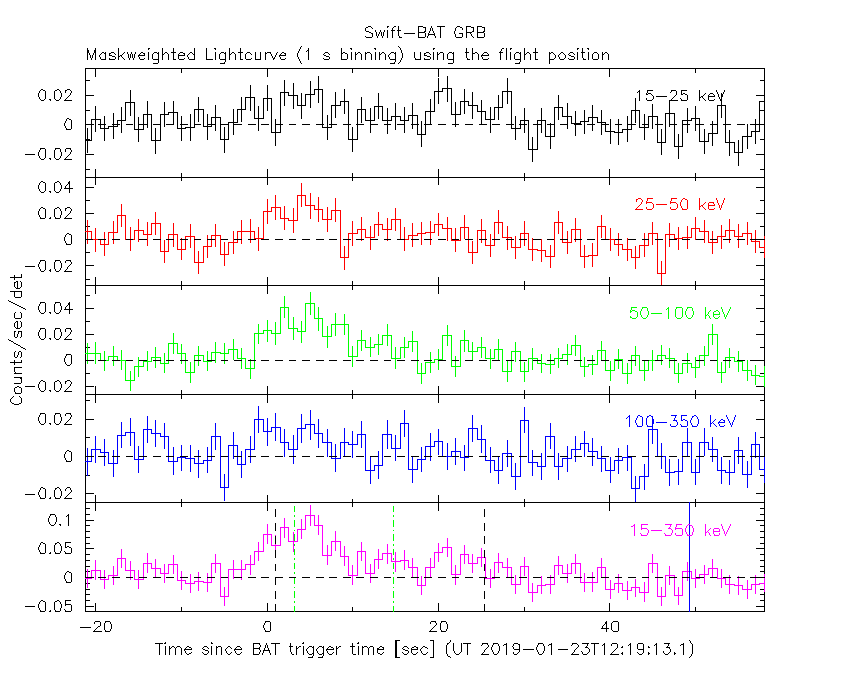
A. D'Ai (INAF-IASFPA), A. Tohuvavohu (PSU) and M.H. Siegel (PSU) for the Swift team
At 12:19:13 UT, the Swift Burst Alert Telescope (BAT) triggered and located GRB 190123A (trigger=885314) (D'Ai et al. GCN Circ. 23769). Swift slewed immediately to the burst. At the time of the trigger, the initial BAT position was 116° from the Sun (7.2 hours East) and 91° from the 92%-illuminated Moon. Table 1 contains the best reported positions from Swift, and the latest XRT position can be viewed at http://www.swift.ac.uk/xrt_positions.
Table 2 is a summary of GCN Circulars about this GRB from observatories other than Swift.
Standard analysis products for this burst are available at https://gcn.gsfc.nasa.gov/swift_gnd_ana.html.
As reported by Lien et al. (GCN Circ. 23780),
the BAT ground-calculated position is RA, Dec = 53.175, 45.505 deg, which is RA(J2000) = 0
The mask-weighted light curve (Figure 1) shows a single FRED-shaped peak from about T-5 to T+20 s, with a peak around T+3 s.
Observations were discontinued due to an observing constraint at ~T+325 s.
The time-averaged spectrum from T-1.22 to T+28.06 s is best fit by a simple power-law model.
The power law index of the time-averaged spectrum is 1.13 ± 0.23.
The fluence in the 15-150 keV band is 8.4 ± 1.1 x 1
The results of the batgrbproduct analysis are available at https://gcn.gsfc.nasa.gov/notices_s/885314/BA/.
Analysis of the initial XRT data was reported by Tohuvavohu et al. (GCN Circ. 23775). We have analysed 13 ks of XRT data for GRB 190123A, from 123 s to 80.3 ks after the BAT trigger. The data comprise 41 s in Windowed Timing (WT) mode with the remainder in Photon Counting (PC) mode. The enhanced XRT position for this burst was given by Beardmore et al. (GCN Circ. 23771).
The light curve (Figure 2) can be modelled with a power-law decay with a decay index of α=1.28 (+0.06, -0.05).
A spectrum formed from the PC mode data can be fitted with an absorbed power-law with a photon spectral index of 1.8 (+0.5, -0.4). The best-fitting absorption column is 2.3 (+0.9, -0.7) x 1
A summary of the PC-mode spectrum is thus:
Total column: 2.3 (+0.9, -0.7) x 1
Galactic foreground: 4.4 x 1
Excess significance: 4.3 σ
Photon index: 1.8 (+0.5, -0.4)
The results of the XRT team automatic analysis are available at http://www.swift.ac.uk/xrt_products/00885314.
The Swift/UVOT began settled observations of the field of GRB 190123A 124 s after the BAT trigger
(Siegel and D'Ai GCN Circ. 23784).
No optical afterglow consistent with the XRT position (Beardmore et al. GCN Circ. 23771) is detected in the initial UVOT exposures.
Table 3 gives preliminary
magnitudes using the UVOT photometric system
(Breeveld et al. 2011, AIP Conf. Proc., 1358, 373).
No correction has been made for the expected extinction in the Milky Way
corresponding to a reddening of

Figure 1. The BAT
mask-weighted light curve in the four individual and total
energy bands. The units are counts

Figure 2. The XRT light curve.
Any data from a crosshatched region are not included in the fit.
| RA (J2000) | Dec (J2000) | Error | Note | Reference |
|---|---|---|---|---|
| 0 |
+45°31'31.1" | 1.6" | XRT-final | UKSSDC |
| 0 |
+45°31'31.1" | 2.3" | XRT-enhanced | Beardmore et al. GCN Circ. 23771 |
| 0 |
+45°30'16.3" | 1.7' | BAT-refined | Lien et al. GCN Circ. 23780 |
| Band | Authors | GCN Circ. | Subject | Observatory | Notes |
|---|---|---|---|---|---|
| Optical | Lipunov et al. | 23770 | MASTER Global Robotic Net optical observation |
MASTER | |
| Optical | Hu et al. | 23772 | BOOTES-4/MET optical limit | BOOTES-4 | upper limits |
| Optical | Steeghs et al. | 23774 | GOTO optical limit | Gravitational-wave Optical Transient Observer | upper limits |
| Optical | Mao et al. | 23777 | GMG observational limit | Gao-Mei-Gu | upper limits |
| Optical | Shiraishi et al. | 23778 | MITSuME Akeno optical upper limits | MITSuME Akeno | upper limits |
| Optical | Watson et al. | 23781 | COATLI Optical Observations | COATLI | |
| Optical | Nakamura and Sakamoto | 23786 | AROMA-N Optical Observation | AROMA-N | |
| Optical | Xu and Zhu | 23788 | NEXT-0.6m optical limit | Xinjiang Astro. Obs. | upper limits |
| Optical | Volnova et al. | 23789 | IKI-GRB-FuN optical upper limit | Zeiss-1000 | upper limits |
| Gamma-ray | Bissaldi | 23773 | Fermi GBM observation | Fermi GBM | Fluence=2.07±0.04x1 (3 |
| Filter | Exp(s) | Mag | ||
|---|---|---|---|---|
| whit |
124 | 250 | 123 | >20.3 |
| white | 124 | 10248 | 1258 | >22.0 |
| v | 3470 | 11721 | 947 | >20.3 |
| b | 4290 | 5926 | 393 | >21.1 |
| u | 4085 | 5721 | 393 | >21.0 |
| w1 | 3880 | 5516 | 393 | >20.1 |
| m2 | 3675 | 5310 | 393 | >19.9 |
| w2 | 4701 | 11151 | 1079 | >21.1 |
Table 3. UVOT observations reported by Siegel and D'Ai (GCN Circ. 23784). The start and stop times of the exposures are given in seconds since the BAT trigger. The preliminary 3-σ upper limits are given. No correction has been made for extinction in the Milky Way.
January 25, 2019